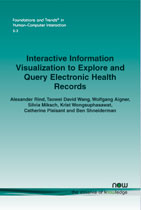Interactive Information Visualization to Explore and Query Electronic Health Records
By Alexander Rind, Vienna University of Technology, Austria, rind@ifs.tuwien.ac.at | Taowei David Wang, University of Maryland, USA, tdwang@partners.org | Wolfgang Aigner, Vienna University of Technology, Austria, aigner@ifs.tuwien.ac.at | Silvia Miksch, Vienna University of Technology, Austria, miksch@ifs.tuwien.ac.at | Krist Wongsuphasawat, University of Maryland, USA, kristw@cs.umd.edu | Catherine Plaisant, University of Maryland, USA, plaisant@cs.umd.edu | Ben Shneiderman, University of Maryland, USA, ben@cs.umd.edu
Abstract
Physicians are confronted with increasingly complex patient histories based on which they must make life-critical treatment decisions. At the same time, clinical researchers are eager to study the growing databases of patient histories to detect unknown patterns, ensure quality control, and discover surprising outcomes. Designers of Electronic Health Record systems (EHRs) have great potential to apply innovative visual methods to support clinical decision-making and research. This work surveys the state-of-the-art of information visualization systems for exploring and querying EHRs, as described in the scientific literature. We examine how systems differ in their features and highlight how these differences are related to their design and the medical scenarios they tackle. The systems are compared on a set of criteria: (1) data types covered, (2) multivariate analysis support, (3) number of patient records used (one or multiple), and (4) user intents addressed. Based on our survey and evidence gained from evaluation studies, we believe that effective information visualization can facilitate analysis of EHRs for patient treatment and clinical research. Thus, we encourage the information visualization community to study the application of their systems in health care. Our monograph is written for both scientific researchers and designers of future user interfaces for EHRs. We hope it will help them understand this vital domain and appreciate the features and virtues of existing systems, so they can create still more advanced systems. We identify potential future research topics in interactive support for data abstraction, in systems for intermittent users, such as patients, and in more detailed evaluations.
Interactive Information Visualization to Explore and Query Electronic Health Records
Physicians are confronted with increasingly complex patient histories based on which they must make life-critical treatment decisions. At the same time, clinical researchers are eager to study the growing databases of patient histories to detect unknown patterns, ensure quality control, and discover surprising outcomes. Designers of Electronic Health Record systems (EHRs) have great potential to apply innovative visual methods to support clinical decision-making and research. This work surveys the state-of-the-art of information visualization systems for exploring and querying EHRs, as described in the scientific literature. It examines how systems differ in their features and highlights how these differences are related to their design and the medical scenarios that they tackle. Some features of the book include: a survey of state-of-the-art information visualization systems from academic literature, a review of the visualization and interaction techniques found in 14 of these systems, including strengths and weaknesses, and compact descriptions of 32 additional EHR visualization systems, a summary of evaluation studies conducted in medical context, an overview of data visualization in commercial EHR systems, and recommendations and future research directions for information visualization in EHR systems. The monograph is written for both scientific researchers and designers of future user interfaces for EHRs. The aim is to help them understand this vital domain and appreciate the features and virtues of existing systems so they can create still more advanced systems. It concludes by identifying potential future research topics in interactive support for data abstraction, in systems for intermittent users, such as patients, and in more detailed evaluations.
